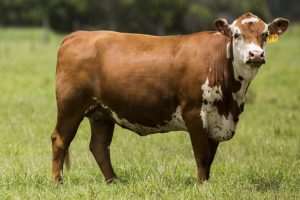Florida residents curious or skeptical about the threat posed by the parasitic screwworm fly Cochliomiya hominivorax can rest assured the insect merits all the attention it has received after an outbreak was detected in the Florida Keys earlier this month, say experts with the University of Florida Institute of Food and Agricultural Sciences.

Commonly known as the primary screwworm fly or New World screwworm fly, the insect threatens the health of warm-blooded animals and people in areas where it is well-established, said Jack Payne, UF senior vice president for agriculture and natural resources.
“To put it plainly, a full-blown screwworm infestation is a death sentence for the host animal,” Payne said. “This pest can kill a previously healthy cow or bull in a matter of weeks if the problem isn’t treated properly. It’s that serious.”
Payne urges all livestock and pet owners to educate themselves about the symptoms of screwworm infestation and seek veterinary care for animals exhibiting tell-tale indications such as open wounds that do not heal, running sores, listlessness, loss of appetite or sudden weight loss.
The fly’s larvae must consume the tissue of a live warm-blooded animal to develop, so adult females lay their eggs on livestock and wildlife with superficial wounds, said veterinary entomologist Phil Kaufman, an associate professor with the UF/IFAS Entomology and Nematology Department.
“From a strictly scientific point of view, screwworm larvae are incredibly well-adapted parasites,” Kaufman said. “That’s why this species was a constant menace to Florida’s cattle industry up through about 1960, when it was eradicated from the state.”
Beginning in the late 1950s, federal and state officials combatted the fly by releasing sterile male specimens, Kaufman noted. Because the female flies mate only once, a female that mates with a sterile male is unable to produce live offspring for the remainder of her lifetime. This practice, known as “sterile insect technique,” can rapidly drive down local populations when used repeatedly. State and federal officials plan to use sterile insect technique to quell the current outbreak.
A member of the blow fly family, C. hominivorax is distinctive from its relatives in Florida because this fly’s larvae will only consume living tissue in host animals, rather than feeding on dead tissue or carrion, he said.
“People who are familiar with the concept of maggot therapy might have the mistaken impression that screwworm larvae simply debride the decaying tissue at the margins of a wound and clean it up,” Kaufman said. “That’s not what happens. Primary screwworm larvae consume living tissue, so they enlarge existing wounds.”
Adult female C. hominivorax flies are attracted by airborne chemicals associated with open wounds, so they often zero in on animals that have sustained minor cuts or scrapes, or have undergone procedures such as castration or dehorning. Similarly, the fly may infect newborn animals with healing wounds where the umbilical cord was severed.
After emerging from eggs, screwworm larvae burrow head-first into nearby tissue, anchoring themselves with a pair of hook-like projections and breathing through two openings called spiracles located in their posterior end, Kaufman said.
On average, the larvae feed for five to seven days before emerging from the host’s body, dropping to the ground and burrowing into leaf litter or soil to pupate and emerge as adults, which are typically metallic bluish-green, about 10 millimeters long, and have the same general structure as a house fly.
Because adult female screwworm flies are attracted to open wounds, a nascent infection can attract additional flies to the host and lead to an ever-greater parasite burden on the animal as new arrivals lay additional eggs.
Although primary screwworm infestations are usually established on or near the skin surface of the host animal, the larvae are capable of burrowing into other tissues, moving into previously uninfected areas.
“In a worst-case scenario, New World screwworm larvae can kill a host animal within a couple of weeks’ time,” Kaufman said. “The hosts often succumb to secondary infections that set in because their immune systems have been weakened by the screwworm infestation.”
Severe infestations where massive tissue damage has occurred may require that the host animal be euthanized, he said, but when cases are detected early and the host receives appropriate veterinary care, chances for recovery are excellent.
Even though there have been no reports of C. hominivorax being detected in Peninsular Florida during the current outbreak, residents who own livestock or pets can assist in the eradication effort by remaining watchful and seeking veterinary care for any animals displaying unusual wounds, sores, lumps or other maladies, Payne said.
“It’s a simple step to take, but you’ll sleep better knowing that you’ve done your part to protect your animals and help end this crisis,” Payne said.
Source: ufl.edu